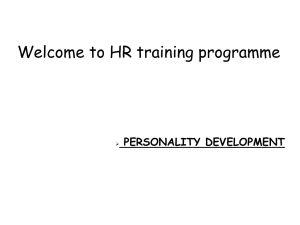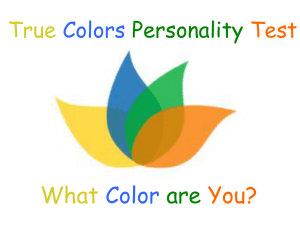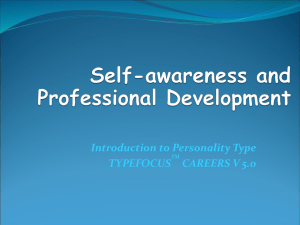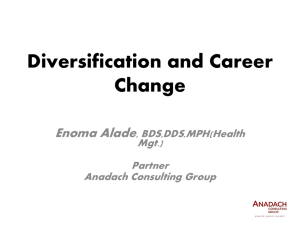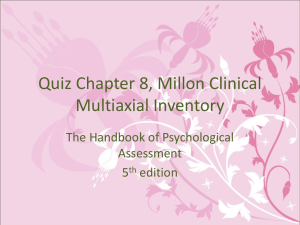Step Up To: Psychology
advertisement
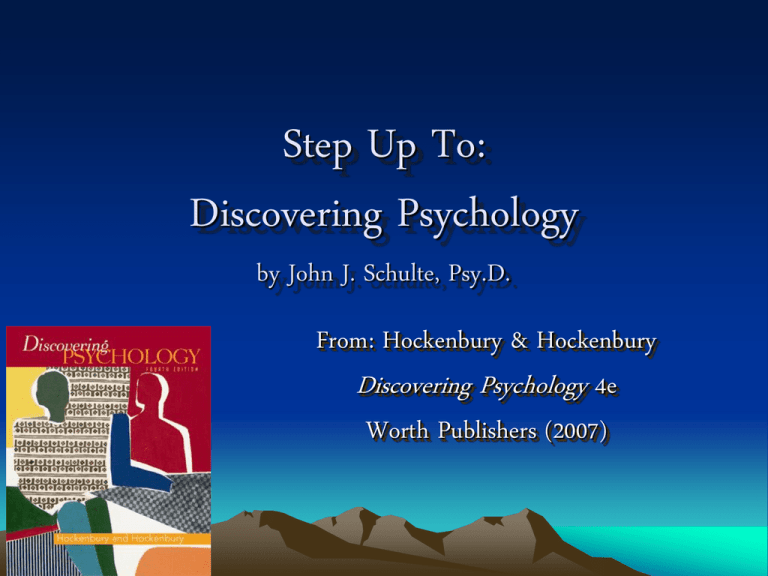
Step Up To: Discovering Psychology by John J. Schulte, Psy.D. From: Hockenbury & Hockenbury Discovering Psychology 4e Worth Publishers (2007) Chapter 10: Personality Use your head! Traits and States Deal with your feelings! Freudian Slips Take a Test Freudian Slips 500 400 300 200 100 Deal with your feelings! 500 400 300 200 100 Use your head! 500 400 300 200 100 Traits and States 500 400 300 200 100 Take a Test 500 400 300 200 100 1. Freud’s technique in which the patient spontaneously reports all thoughts, feelings, and images as they come to mind is called ___ . • • • • A) psychoanalysis B) dream interpretation C) free association D) psychotherapy 2. According to Freud, “I want it, and I want it now,” refers to the part of the personality called the: • • • • A) superego. B) id. C) ego. D) eros. 3. Threatened by his own attraction to other males, Mr. Jones leads an active campaign against gay rights. He is displaying the ego defense mechanism called ___. • • • • A) denial B) reaction formation C) sublimation D) displacement 4. Jung believed that the deepest part of the individual psyche is that which is shared by all people, called: • • • • A) identification. B) fixation. C) the Oedipus complex. D) the collective unconscious. 5. According to Freud, in the film The Wizard of Oz , Dorothy, the Cowardly Lion, the Tin Woodsman, and the Scarecrow are all: • A) psychosexual stages of development. • B) ego defense mechanisms. • C) archetypes. • D) dream interpretations. 6. According to Rogers, the most basic human motive is the innate drive to maintain and enhance, called: • • • • A) the actualizing tendency. B) the self-concept. C) aggressive instincts. D) the sense of self. 7. Humanistic psychologists differed from psychoanalytic theorists in their focus on: • • • • A) reinforced behaviors. B) unconscious motives. C) the healthy personality. D) early childhood influences. 8. “I do not approve of your behavior, but I still love and value you.” This attitude shows that a parent has ___ for his/her child. • • • • A) actualizing tendency B) unconditional positive regard C) compassionate parenting D) conditional positive regard 9. Rogers believed that the fully functioning person: • A) is likely to be creative and spontaneous. • B) enjoys harmonious relationships with others. • C) has self-awareness and free-will. • D) demonstrates all of the above. 10. Which of the following is a major criticism of the humanistic perspective? • A) It minimizes the destructive side of human nature. • B) It has no relevance to psychotherapy. • C) It discounts the idea of a healthy personality. • D) It is based solely on childhood memories and conflicts. 11. Bandura explains behavior and personality as being caused by the interaction of behavioral, cognitive, and environmental factors. This process is called: • • • • A) self-efficacy. B) social cognitive theory. C) social-cultural psychology. D) reciprocal determinism. 12. Bandura describes self-efficacy as: • A) being the best that one can be. • B) feelings of self-confidence or selfdoubt. • C) the sense of being loved and accepted by others. • D) the drive to learn despite early failures. 13. The social cognitive perspective differs from the humanistic perspective in that social cognitive theorists: • A) deal with free-will. • B) emphasize feelings and insight. • C) rely heavily on experimental findings. • D) have less scientific fact on which to base their theory. 14. The social cognitive perspective places most of the responsibility for our behavior: • • • • A) on ourselves. B) on our childhood history. C) on our learned behavior. D) on the way we were parented. 15. Some psychologists criticize the social cognitive theory, claiming: • A) it is too scientific. • B) it lacks description of the whole person. • C) its theories are descriptive and not testable. • D) it has no relevance to psychotherapy. 16. A trait is: • A) an unconscious motive driving our behavior. • B) a repeated pattern of behavior. • C) a description of our outward appearance. • D) a relatively stable, enduring predisposition to consistently behave in a certain way. 17. Source traits are: • A) the most fundamental dimensions of personality. • B) personality characteristics that can easily be inferred from observable behavior. • C) similarities between people. • D) personality factors we inherit from our parents. 18. According to Eysenck, someone low on psychoticism: • A) is excitable, changeable and impulsive. • B) is antisocial, cold, hostile, and unconcerned about others. • C) is warm and caring toward others. • D) is sober, pessimistic and rigid. 19. More recent trait theorists believe Cattell proposed too many traits and Eysenck too few, resulting in the: • A) modern cognitive-behavioral model. • B) five-factor model. • C) neo-Freudian perspective. • D) Sixteen PF Questionnaire. 20. Evidence for genetic influence is particularly strong for which of the following Big Five personality traits? • A) agreeableness and extraversion • B) conscientiousness and agreeableness • C) neuroticism and agreeableness • D) extroversion and neuroticism 21. A projective test that requires a person to look at several pictures and make up stories is the: • • • • A) Rorschach Inkblot Test. B) MMPI. C) 16 PF. D) Thematic Apperception Test. 22. The most widely used personality test is currently the: • • • • A) Rorschach Inkblot Test. B) MMPI. C) TAT. D) 16PF. 23. The main difference between the MMPI and the California Personality Inventory (CPI) is that the CPI: • A) was designed to assess normal populations. • B) is a much longer process than the MMPI. • C) is based on other people’s observations of us. • D) was designed for use on clinical populations. 24: A major advantage of objective personality tests over projective ones is that: • A) objective tests measure unconscious motives. • B) objective tests are more difficult to fake. • C) reliability and validity of objective tests are higher. • D) all of the above. 25. The objective personality test based on the trait theory of Raymond Cattell is the: • • • • A) 16PF. B) MMPI. C) CPI. D) TAT. Stop here, or continue as a review 1. Freud’s technique in which the patient spontaneously reports all thoughts, feelings, and images as they come to mind is called ____ . • • • • A) psychoanalysis B) dream interpretation C) free association D) psychotherapy 399 2. According to Freud, “I want it, and I want it now,” refers to the part of the personality called the: • • • • A) superego. B) id. C) ego. D) eros. 401 3. Threatened by his own attraction to other males, Mr. Jones leads an active campaign against gay rights. He is displaying the ego defense mechanism called ____ : • • • • A) denial. B) reaction formation. C) sublimation. D) displacement. 403 4. Jung believed that the deepest part of the individual psyche is that which is shared by all people, called: • • • • A) identification. B) fixation. C) the Oedipus complex. D) the collective unconscious. 407 5. According to Freud, in the film The Wizard of Oz , Dorothy, the Cowardly Lion, the Tin Woodsman, and the Scarecrow are all: • A) psychosexual stages of development. • B) ego defense mechanisms. • C) archetypes. • D) dream interpretations. 408 6. According to Rogers, the most basic human motive is the innate drive to maintain and enhance, called: • • • • A) the actualizing tendency. B) the self-concept. C) aggressive instincts. D) the sense of self. 412 7. Humanistic psychologists differed from psychoanalytic theorists in their focus on: • • • • A) reinforced behaviors. B) unconscious motives. C) the healthy personality. D) early childhood influences. 412 8. “I do not approve of your behavior, but I still love and value you.” This attitude shows that a parent has ___ for his/her child. • • • • A) actualizing tendency B) unconditional positive regard C) compassionate parenting D) conditional positive regard 412 9. Rogers believed that the fully functioning person: • A) is likely to be creative and spontaneous. • B) enjoys harmonious relationships with others. • C) has self-awareness and free-will. • D) demonstrates all of the above. 414 10. Which of the following is a major criticism of the humanistic perspective? • A) It minimizes the destructive side of human nature. • B) It has no relevance to psychotherapy. • C) It discounts the idea of a healthy personality. • D) It is based solely on childhood memories and conflicts. 415 11. Bandura explains behavior and personality as being caused by the interaction of behavioral, cognitive, and environmental factors. This process is called: • • • • A) self-efficacy. B) social cognitive theory. C) social-cultural psychology. D) reciprocal determinism. 416 12. Bandura describes self-efficacy as: • A) being the best that one can be. • B) feelings of self-confidence or selfdoubt. • C) the sense of being loved and accepted by others. • D) the drive to learn despite early failures. 417 13. The social cognitive perspective differs from the humanistic perspective in that social cognitive theorists: • A) deal with free-will. • B) emphasize feelings and insight. • C) rely heavily on experimental findings. • D) have less scientific fact on which to base their theory. 416 14. The social cognitive perspective places most of the responsibility for our behavior: • • • • A) on ourselves. B) on our childhood history. C) on our learned behavior. D) on the way we were parented. 418 15. Some psychologists criticize the social cognitive theory, claiming: • A) it is too scientific. • B) it lacks description of the whole person. • C) its theories are descriptive and not testable. • D) it has no relevance to psychotherapy. 418 16. A trait is: • A) an unconscious motive driving our behavior. • B) a repeated pattern of behavior. • C) a description of our outward appearance. • D) a relatively stable, enduring predisposition to consistently behave in a certain way. 418 17. Source traits are: • A) the most fundamental dimensions of personality. • B) personality characteristics that can easily be inferred from observable behavior. • C) similarities between people. • D) personality factors we inherit from our parents. 419 18. According to Eysenck, someone low on psychoticism: • A) is excitable, changeable and impulsive. • B) is antisocial, cold, hostile, and unconcerned about others. • C) is warm and caring toward others. • D) is sober, pessimistic, and rigid. 420 19. More recent trait theorists believe Cattell proposed too many traits and Eysenck too few, resulting in the: • A) modern cognitive-behavioral model. • B) five-factor model. • C) neo-Freudian perspective. • D) Sixteen PF Questionnaire. 421 20. Evidence for genetic influence is particularly strong for which of the following Big Five personality traits? • A) agreeableness and extraversion • B) conscientiousness and agreeableness • C) neuroticism and agreeableness • D) extroversion and neuroticism 423 21. A projective test that requires a person to look at several pictures and make up stories is the: • • • • A) Rorschach Inkblot Test. B) MMPI. C) 16 PF. D) Thematic Apperception Test. 426 22. The most widely used personality test is currently the: • • • • A) Rorschach Inkblot Test. B) MMPI. C) TAT. D) 16PF. 428 23. The main difference between the MMPI and the California Personality Inventory is that the CPI: • A) was designed to assess normal populations. • B) is a much longer process than the MMPI. • C) is based on other people’s observations of us. • D) was designed for use on clinical populations. 428 24: A major advantage of objective personality tests over projective ones is that: • A) objective tests measure unconscious motives. • B) objective tests are more difficult to fake. • C) reliability and validity of objective tests are higher. • D) all of the above. 430 25. The objective personality test based on the trait theory of Raymond Cattell is the: • • • • A) 16PF. B) MMPI. C) CPI. D) TAT. 429 Acknowledgments • Step Up Created by: John J. Schulte, Psy.D. • Based on Discovering Psychology 4e by Hockenbury & Hockenbury • Worth Publishers, 2007 Answers 1. 2. 3. 4. 5. 6. 7. 8. C B B D C A C B 9. 10. 11. 12. 13. 14. 15. 16. D A D B C A B D 17. 18. 19. 20. 21. 22. 23. 24. A C B D D B A C 25. D






